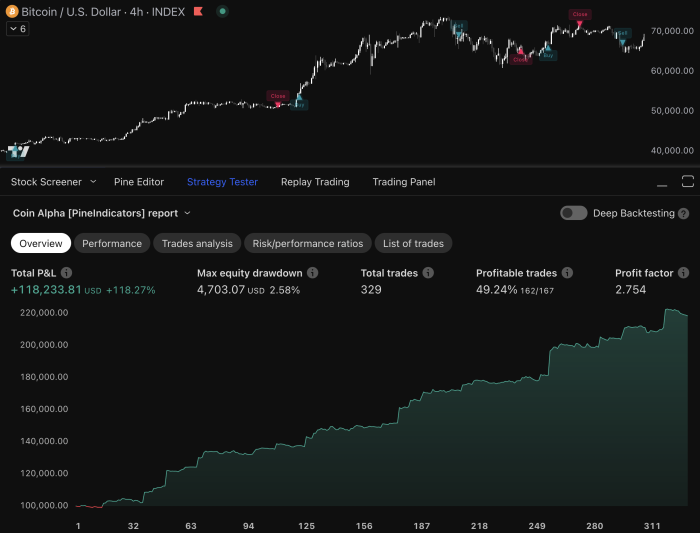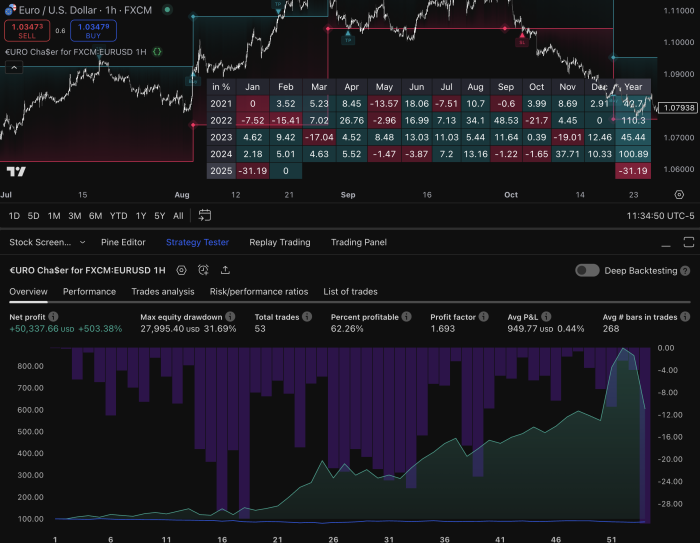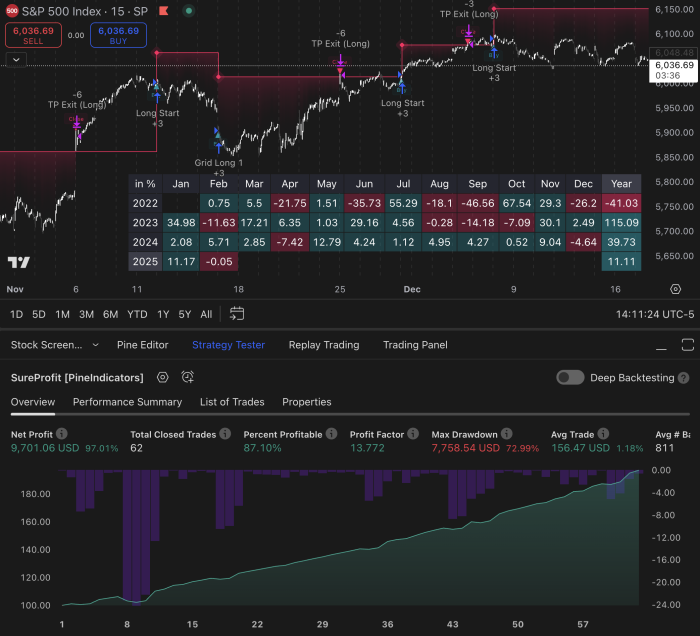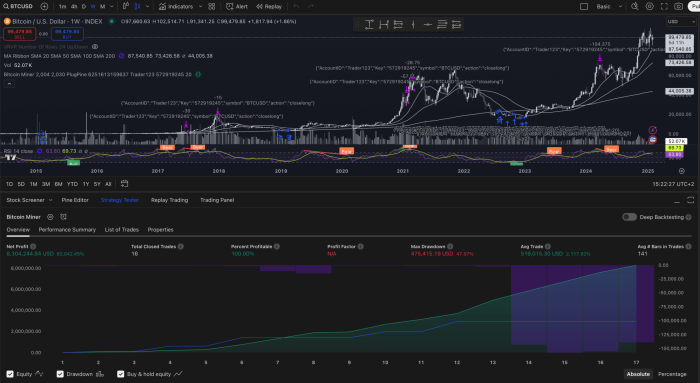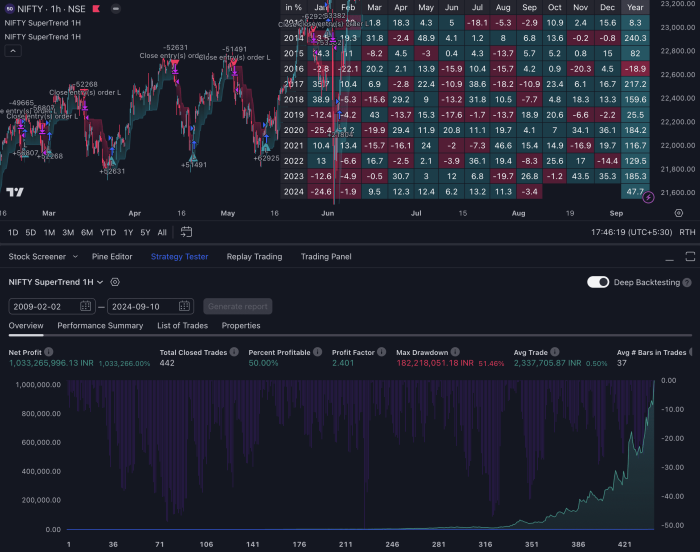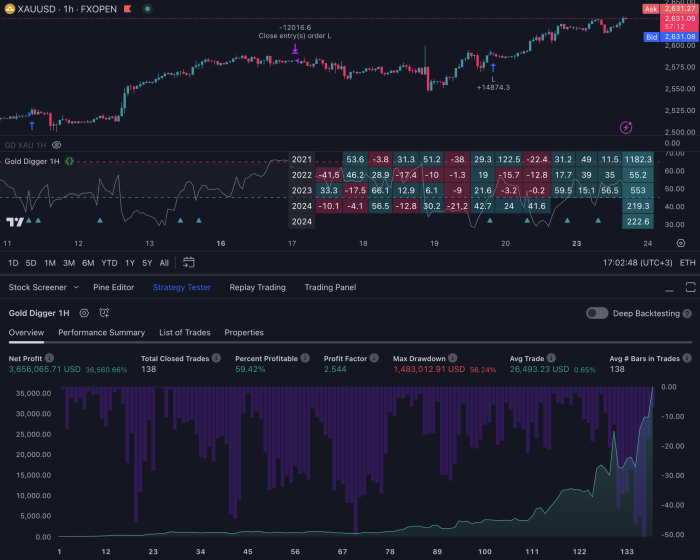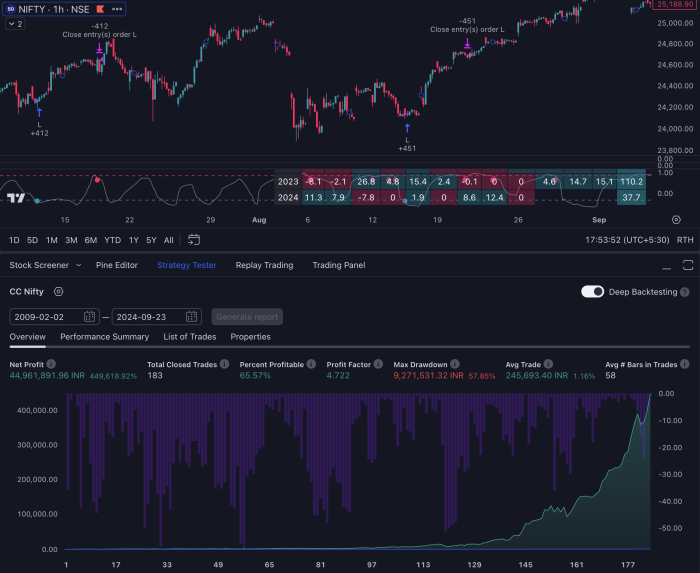Introduction
Trading in trending markets presents one of the most lucrative opportunities for traders. A trending market shows a sustained price movement in a specific direction – either upward (bullish) or downward (bearish).
You’ll find trending markets across various timeframes and asset classes. These markets display consistent price movements that create predictable patterns, making them ideal for both novice and experienced traders.
Why Trading Trending Markets Matters:
- Higher probability of successful trades
- Clearer entry and exit points
- Better risk-to-reward ratios
- Potential for capturing larger price movements
This guide will equip you with essential knowledge about trend trading, including:
- Identifying different types of trends
- Using technical indicators effectively such as those available in our Advanced Pine Script tutorials
- Developing robust trading strategies with the help of Pine Script templates
- Implementing risk management techniques
- Understanding market influences
- Balancing specialization and diversification
Whether you’re new to trading or looking to refine your approach, mastering trend trading can significantly improve your trading performance. With the right tools like custom indicator scripts for TradingView, you can enhance your trading strategies. Additionally, leveraging trading signals from TradingView can provide you with clearer entry and exit points. Let’s explore how you can capitalize on market trends using proven strategies and tools, including effective technical analysis on TradingView.
Understanding Trending Markets
Market trends represent directional price movements that persist over specific time periods. These movements create recognizable patterns traders can identify and leverage for profitable opportunities.
Types of Trends
Uptrend
- Higher highs and higher lows in price action
- Bullish market sentiment
- Opportunities for buy positions
- Support levels tend to hold
Downtrend
- Lower highs and lower lows in price action
- Bearish market sentiment
- Opportunities for sell positions
- Resistance levels tend to hold
Trend Timeframes
Long-term Trends (8 months – 2 years)
- Reflect major market cycles and economic conditions
- Suitable for position trading strategies such as those found in the high profit trading strategies on TradingView
- Less affected by short-term market noise
- Require larger stop losses due to price swings
- Popular among institutional investors
Medium-term Trends (1 – 8 months)
- Capture intermediate market movements
- Ideal for swing trading approaches, which can be optimized with Forex Pine Script strategies
- Balance between volatility and stability
- Allow for multiple trading opportunities
- Require moderate position sizing
Short-term Trends (Several days – 1 month)
- Quick price movements and reversals
- Perfect for day trading and scalping strategies
- Higher frequency of trading signals
- Tighter stop losses possible
- Need active market monitoring
Impact on Trading Strategies
Your chosen timeframe directly influences your trading approach:
Short-term Trading
- Requires quick decision-making
- Uses smaller position sizes
- Focuses on technical analysis, often supported by Forex indicator scripts on TradingView
- Demands active screen time
- Suits aggressive trading styles like scalping
Medium-term Trading
- Combines technical and fundamental analysis
- Allows for planned entries and exits based on thorough analysis, akin to the best strategies for crypto trading
- Reduces trading frequency
- Balances risk and reward effectively
Long-term Trading
- Emphasizes fundamental factors
- Reduces trading costs
- Minimizes emotional decision-making
- Requires patience and discipline
- Suits conservative trading styles
Each trend timeframe offers unique advantages and challenges. Short-term trends provide frequent opportunities but demand constant attention. Medium-term trends balance analysis time with trading frequency. Long-term trends reduce trading stress but require larger capital commitments.
Your selection of timeframe depends on your trading goals, available time, and risk tolerance. Many successful traders combine multiple timeframes to confirm trading decisions and improve accuracy.
Stages of a Trend
A trend’s lifecycle consists of four distinct stages, each presenting unique trading opportunities and risks. Understanding these stages helps you make informed decisions about entry and exit points.
Stage 1: Young Trend
- Clear directional movement with strong momentum
- Low volatility and steady price progression
- Minimal resistance in the trend direction
- Ideal entry point for position trades
Stage 2: Mature Trend
- Established direction with increased trading volume
- Higher volatility with notable price swings
- Regular retracements followed by trend continuation
- Best suited for swing trading strategies
Stage 3: Aging Trend
- Decreased momentum and increased volatility
- Longer consolidation periods between moves
- Failed breakout attempts become common
- Requires tighter stop-loss management
Stage 4: Reversing Trend
- Break of major support/resistance levels
- Sharp price movements against the primary trend
- Higher volume during counter-trend moves
- Signal to exit positions or prepare for reverse trades
Each stage requires different trading approaches. Young trends favor aggressive position sizing, while aging trends demand more conservative strategies. Mature trends offer multiple entry opportunities during retracements. Reversing trends signal the need for position closure or trend reversal trades.
To effectively navigate these stages, it’s essential to utilize various tools such as Pine Script, which can aid in creating custom indicators that help identify these stages more accurately. Price action patterns, volume analysis, and momentum indicators help identify these stages. You’ll notice changes in volatility, trading volume, and price movement characteristics as trends progress through their lifecycle. Successful trend trading depends on adapting your strategy to match the current stage of the trend.
Analyzing Trends with Technical Indicators
Technical indicators are crucial for trend trading. They provide objective insights to confirm market movements and spot potential trading opportunities. If you’re looking to improve your trading strategies, checking out the best TradingView indicators for 2024 could make a significant difference.
1. Moving Averages (MAs)
Moving Averages (MAs) serve as flexible support and resistance levels, assisting you in identifying trend directions and possible reversal points. The most frequently used combinations include:
- 50-day and 200-day MAs for long-term trends
- 20-day and 50-day MAs for medium-term trends
- 5-day and 13-day MAs for short-term trends
2. Relative Strength Index (RSI)
The Relative Strength Index (RSI) gauges the speed and extent of price changes. When trading trends, you might want to implement some effective RSI strategies for TradingView:
- RSI readings above 70 indicate overbought conditions
- RSI readings below 30 signal oversold conditions
- RSI divergence can predict potential trend reversals
3. Average Directional Index (ADX)
The Average Directional Index (ADX) helps determine trend strength:
- ADX values above 25 indicate strong trends
- ADX values below 20 suggest weak or no trend
- Rising ADX values confirm trend strength
- Falling ADX values signal potential trend weakness
These indicators work best when used together. For instance, you might confirm a strong uptrend when the price stays above the 50-day MA, RSI remains between 40-80, and ADX shows readings above 25.
In addition to these traditional indicators, incorporating advanced tools like the Versatile Bollinger Band Cascade could further enhance your trading experience. This adaptive trading system offers unique features and customization options that make it stand out in the crowded world of trading algorithms.
Lastly, don’t forget to explore the top Pine Script strategies on TradingView. These strategies can significantly enhance your trading with custom indicators and effective techniques, making your analysis more robust and your trades more successful.
Developing a Trend Trading Strategy
Creating a successful trend trading strategy requires a systematic approach that combines multiple market analysis methods. Here’s how you can develop your own effective strategy:
Determining Trade Duration
Your trade duration should align with the market conditions you’re trading in:
- Short-term trades (1-5 days): Best during high volatility periods with clear directional movement
- Medium-term trades (1-8 weeks): Suitable for steady trending markets with consistent price action
- Long-term trades (2+ months): Ideal for strong fundamental trends and major market shifts
Identifying Current Market Trends
You can spot active trends using these proven techniques:
Price Action Analysis
- Look for higher highs and higher lows in uptrends
- Watch for lower lows and lower highs in downtrends
- Monitor volume to confirm trend strength
Multiple Timeframe Analysis
- Start with higher timeframes to identify primary trend
- Use lower timeframes to pinpoint entry points
- Ensure alignment across different timeframes
Fundamental Analysis Integration
Strong trend trading strategies incorporate fundamental factors:
Economic Indicators
- GDP growth rates
- Employment data
- Inflation rates
Market Sentiment
- Institutional investor positions
- Retail trading sentiment
- Options market activity
Your strategy should adapt to changing market conditions. Track your trades using a detailed trading journal to identify which setups work best in different market environments. It’s also beneficial to test your strategy on historical data before implementing it with real capital. Utilizing tools like the TradingView Strategy Tester can greatly assist in this process.
Remember to align your position sizing with your risk tolerance and account for market volatility when setting stop-loss levels. A well-structured trend trading strategy combines technical analysis, fundamental factors, and proper risk management techniques.
Risk Management in Trend Trading Strategy
Risk management is crucial for successful trend trading. It involves implementing specific measures to protect your trading capital and secure profits.
Essential Risk Management Techniques:
- Set a maximum risk percentage per trade (1-2% of total capital)
- Use proper position sizing based on account equity
- Maintain a risk-reward ratio of at least 1:2
- Keep a trading journal to track and analyze performance
Stop-Loss Orders: Your Safety Net
Stop-loss orders are automatic exit points when trades move against you. Place them at:
- Below recent support levels for uptrends
- Above recent resistance levels for downtrends
- Just beyond the average daily range to avoid premature exits
Limit Orders: Securing Profits
Limit orders help lock in gains at predetermined price levels. Consider these placement strategies:
- Set partial profit targets at key resistance/support levels
- Scale out of positions by closing portions at different price points
- Use trailing stops to protect profits as trends develop
Risk Adjustment Techniques
Adjust your risk parameters based on:
- Market volatility levels
- Trend strength (measured by ADX)
- Trading timeframe
- Current market conditions
Remember to regularly review and adjust your risk management strategy as market conditions change. A solid risk management approach protects your capital during inevitable market reversals and helps maintain consistent trading performance.
Incorporating advanced techniques such as Advanced Pine Script Strategies for TradingView, can further enhance your trading performance by providing better backtesting and risk management capabilities.
Staying Informed About Market Influences
Market trends don’t exist in isolation – they’re shaped by a complex web of economic indicators, news events, and policy decisions. Your success in trend trading depends on your ability to stay informed about these market-moving forces.
Key Economic Indicators to Monitor:
- GDP growth rates
- Employment figures
- Inflation data
- Consumer confidence indexes
- Manufacturing output
Central Bank Policies
Central banks wield significant influence over market trends through their monetary policies. Interest rate decisions, quantitative easing programs, and policy statements can trigger immediate market reactions and establish long-term trends.
For example, when the Federal Reserve signals a hawkish stance, the USD typically strengthens against other currencies, creating clear trending opportunities in forex pairs.
Political Events Impact
Political developments can create powerful market trends:
- Elections
- Trade agreements
- Regulatory changes
- International conflicts
- Policy shifts
You’ll find the most reliable trends by combining technical analysis with awareness of these fundamental factors. Set up news alerts for your traded markets and maintain a economic calendar to track scheduled announcements.
Pro Tip: Create a personalized news dashboard focusing on the specific assets or markets you trade. This helps filter out noise and concentrate on relevant information that could affect your trading positions.
Specialization vs. Diversification in Trading
Trading success often depends on your approach to the market: specialization or diversification. Each strategy has its own advantages and challenges for trend traders.
Benefits of Specialization:
- Deep understanding and expertise in a specific market
- Tailored trading strategies that are specific to that market
- Ability to quickly identify patterns
- Less time spent on research
- Improved skill in spotting unusual market behavior
Drawbacks of Specialization:
- Limited opportunities available
- Higher risk of downturns in that specific market
- Possibility of missing out on opportunities in other markets
Benefits of Diversification:
- Spreading risk across multiple markets
- Accessing different trading opportunities
- Protection against volatility in a specific market
- Potential for steady returns
Challenges of Diversification:
- Difficulty in monitoring multiple markets
- Divided focus across different markets
- Steeper learning curve
- Increased need for research
Your decision between specialized trading strategies and diversified portfolios depends on your trading goals, time commitment, and risk tolerance. Specialized traders may concentrate solely on cryptocurrency trends, while diversified traders could simultaneously monitor forex, commodities, and stock market movements.
Many successful traders begin by specializing in one market, mastering its intricacies before broadening their focus. This method allows for skill development while keeping risk levels manageable. You can test specialized strategies on PineIndicators.com to find your ideal market focus.
The debate between specialization and diversification is not just limited to trading but extends to broader economic strategies as well. Each approach has its own set of pros and cons, which can also be observed in various sectors. For instance, while diversification can provide economic stability by spreading risk, specialization may lead to higher returns by focusing on a specific area of expertise.
Conclusion
Trading in trending markets requires dedication, practice, and a well-structured approach. The strategies discussed here serve as your foundation for successful trading practices. Start by mastering one technique at a time, like our EMA crossover strategy, and gradually expand your trading toolkit as your confidence grows.
Remember these key elements for success:
- Identify trend stages accurately
- Use technical indicators wisely
- Implement robust risk management
- Stay informed about market influences
Your journey toward becoming a skilled trend trader doesn’t end here. Markets evolve, and successful traders commit to continuous learning and strategy refinement. For instance, you can explore our collection of high-performing trading strategies at PineIndicators.com.
These strategies not only provide insights into spotting profitable trends but also help in making informed trading decisions. Additionally, consider leveraging our resources on backtesting Pine Script strategies or automated Pine Script strategies to further enhance your trading performance.
Start implementing these strategies today, and watch your trading skills grow.
FAQs (Frequently Asked Questions)
What are trending markets?
Trending markets refer to market conditions where prices consistently move in a particular direction, either upward (uptrend) or downward (downtrend). Understanding these trends is crucial for traders as they indicate potential opportunities for profit.
What are the different types of trends in trading?
There are three main types of trends: long-term trends (lasting from 8 months to 2 years), medium-term trends (ranging from 1 to 8 months), and short-term trends (spanning several days to 1 month). Each type influences trading strategies differently based on their duration and price movements.
How do I analyze trends using technical indicators?
Popular technical indicators used in trend trading include moving averages (MAs), relative strength index (RSI), and average directional index (ADX). These tools help traders assess the strength and direction of a trend, facilitating informed trading decisions.
What is the importance of risk management in trend trading?
Risk management is essential in trend trading as it helps protect trades and secure profits. Techniques such as stop-loss orders and limit orders play a crucial role in mitigating potential losses, ensuring that traders can manage their risks effectively.
How can news events influence market trends?
Staying informed about relevant news and economic indicators is vital since they can significantly impact market trends. Central bank policies, political events, and other news can lead to volatility and shifts in currency pairs, affecting trading strategies.
Should I specialize in one market or diversify across multiple markets?
Both specialization and diversification have their benefits and drawbacks. Specializing allows for deeper knowledge of a specific market, while diversifying helps capture varied trends across multiple markets. Traders should consider their individual goals and risk tolerance when making this decision.

